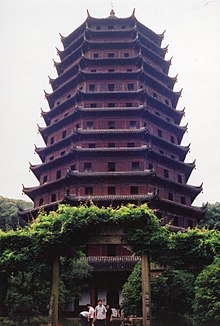Pagoda of the Six Harmonies
The Pagoda of the Six Harmonies or Liuhe Pagoda ( Chinese 六和塔 , Pinyin Liùhé Tǎ ) about 8 km southwest of the Chinese city of Hangzhou , Zhejiang Province , at the foot of the Yuelun Mountain (Yuelun Feng) on the north bank of the Qiantang River was built in 970 by King Qian Hongchu ( 钱 弘 俶 , i. e. Qian Chu; r. 948–978) of the Wu Yue Kingdom in the time of the Northern Song Dynasty and after the destruction in the Fang La Rebellion (1121) in the Rebuilt during the Southern Song Dynasty (1165).
The octagonal pagoda is 60 m high and has 13 floors (seven inside). Its wood paneling has been renewed several times (the last one dates from 1900 of the Qing period ), but the brick core dates from the Song Dynasty . The ceilings of the floors are colorfully decorated with flowers, birds and other animals. The pagoda also served as a lighthouse.
It has been on the list of monuments of the People's Republic of China (1-72) since 1961 .
Web links
Coordinates: 30 ° 11 ′ 54 ″ N , 120 ° 7 ′ 36 ″ E

